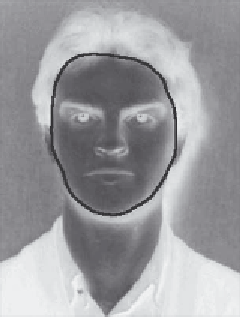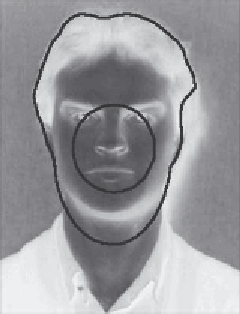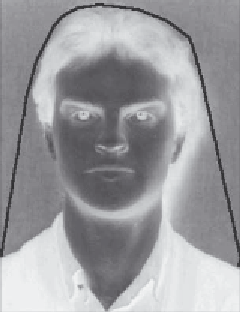Image Processing Reference
In-Depth Information
(a) Outer boundary initialisation
(b) Outer and inner contours
(c) Final face boundary
Figure 6.10
Extracting the face outline by a discrete dual contour
shapes. Rather than rely on finding the border of a shape, or its shape, it locates features
according to their
symmetrical properties
. The operator essentially forms an
accumulator
of points that are measures of symmetry between image points. Pairs of image points are
attributed symmetry values that are derived from a
distance
weighting function, a
phase
weighting function and the
edge
magnitude at each of the pair of points. The distance
weighting function controls the scope of the function, to control whether points which are
more distant contribute in a similar manner to those which are close together. The phase
weighting function shows when edge vectors at the pair of points point to each other. The
symmetry accumulation is at the centre of each pair of points. In this way the accumulator
measures the degree of symmetry between image points, controlled by the edge strength.
The distance weighting function
D
is
|
PP
- |
2
i
j
1
2
-
σ
Di j
(, , ) =
σ
e
(6.46)
πσ
where
i
and
j
are the indices to two image points
P
i
and
P
j
and the deviation
controls the
scope of the function, by scaling the contribution of the distance between the points in
the exponential function. A small value for the deviation
σ
σ
implies local operation and
detection of local symmetry. Larger values of
imply that points that are further apart
contribute to the accumulation process, as well as ones that are close together. In, say,
application to the image of a face, large and small values of
σ
σ
will aim for the whole face
or the eyes, respectively.
The effect of the value of
on the distance weighting function is illustrated in Figure
6.11
. Figure
6.11
(a) shows the effect of a small value for the deviation,
σ
= 0.6, and shows
that the weighting is greatest for closely spaced points and drops rapidly for points with
larger spacing. Larger values of
σ
imply that the distance weight drops less rapidly for
points that are more widely spaced, as in Figure
6.11
(b) where
σ
= 5, allowing points
which are spaced further apart to contribute to the measured symmetry. The phase weighting
function
P
is
σ





















